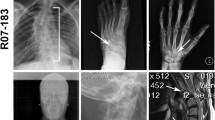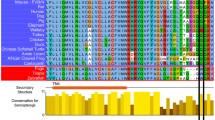Abstract
The mechanical loading of striated muscle is thought to play an important role in shaping bones and joints. Here, we examine skeletogenesis in late embryogenesis (embryonic day 18.5) in Myf5 −/− :MyoD −/− fetuses completely lacking striated muscle. The phenotype includes enlarged and fused cervical vertebrae and postural anomalies, some viscerocranial anomalies, long bone truncation and fusion, absent deltoid tuberosity of the humerus, scapular and clavicular hypoplasia, cleft palate, and cleft sternum. In contrast, neurocranial bone development was essentially normal. While the magnitude of individual effects varied throughout the skeletal system, the results are consistent with skeletal development depending on functional muscles. Novel abnormalities in the amyogenic fetuses relative to less severely paralyzed phenotypes extend our understanding of skeletogenic dependence on embryonic muscle contraction and static loading.







Similar content being viewed by others
References
Braun T, Rudnicki MA, Arnold HH, Jaenisch R (1992) Targeted inactivation of the muscle regulatory gene Myf-5 results in abnormal rib development and perinatal death. Cell 71:369–382
Brennan TJ, Olson EN, Klein WH, Winslow JW (1996) Extensive motor neuron survival in the absence of secondary skeletal muscle fiber formation. J Neurosci Res 45:57–68
Bertram JEA, Biewener AA (1990) Differential scaling of the long bones in the terrestrial Carnivora and other mammals. J Morphol 204:157–169
Chiu DT, Crikelair GF, Moss ML (1979) Epigenetic regulation of the shape and position of the auricle in the rat. Plast Reconstr Surg 63:411–417
Farnum CE (1994) Differential growth rates of long bones. In: Hall BK (ed) Bone: mechanisms of bone development and growth, vol 8. CRC, Boca Raton, pp 193–222
Farnum CE (2005) Postnatal growth of fins and limbs through endochondral ossification. In: Hall BK (ed) Fins and limbs: development, evolution and transformation. The University of Chicago Press, Chicago
Greene EC (1935) Anatomy of the rat. Trans Am Philos Soc 27:1–370 (reprinted 1968, Hafner, Philadelphia, pp 1–84)
Hall BK (1994) Embryonic bone formation with special reference to epithelial–mesenchymal interactions and growth factors. In: Hall BK (ed) Bone: mechanisms of bone development and growth, vol 8. CRC, Boca Raton, pp 154–155
Hall BK (ed) (2005) Fins and limbs: development, evolution and transformation. The University of Chicago Press, Chicago
Hall BK, Herring SW (1990) Paralysis and growth of the musculoskeletal system in the embryonic chick. J Morphol 206:45–56
Harris AJ, Duxson MJ, Fitzsimons RB, Rieger F (1989) Myonuclear birthdates distinguish the origins of primary and secondary myotubes in embryonic mammalian skeletal muscles. Development 107:771–784
Hasty P, Bradley A, Morris JH, Edmondson DG, Venuti JM, Olson EN, Klein WH (1993) Muscle deficiency and neonatal death in mice with a targeted mutation in the myogenin gene. Nature 364:501–506
Herring SW (1994) Development of functional interactions between skeletal and muscular systems. In: Hall BK (ed) Bone: differentiation and morphogenesis of bone, vol 9. CRC, Boca Raton, pp 165–191
Herring SW, Lakars TC (1982) Craniofacial development in the absence of muscle contraction. J Craniofac Genet Dev Biol 1:341–357
Kablar B (2002) Different regulatory elements within the MyoD promoter control its expression in the brain and inhibit its functional consequences in neurogenesis. Tissue Cell 34:164–169
Kablar B, Krastel K, Tajbakhsh S, Rudnicki MA (2003) Myf5 and MyoD activation define independent myogenic compartments during embryonic development. Dev Biol 258:307–318
Kablar B, Krastel K, Ying C, Tapscott SJ, Goldhamer DJ, Rudnicki MA (1999) Myogenic determination occurs independently in somites and limb buds. Dev Biol 206:219–231
Kablar B, Rudnicki MA (1999) Development in the absence of skeletal muscle results in the sequential ablation of motor neurons from the spinal cord to the brain. Dev Biol 208:93–109
Kablar B, Rudnicki MA (2000) Skeletal muscle development in the mouse embryo. Histol Histopathol 15:649–656
Kablar B, Rudnicki MA (2002) Information provided by the skeletal muscle and associated neurons is necessary for proper brain development. Int J Dev Neurosci 20:573–584
Kaufman MH (1999) The atlas of mouse development. Academic, San Diego
Koo SH, Cunningham MC, Arabshahi B, Gruss JS, Grant JH III (2001) The transforming growth factor-beta 3 knock-out mouse: an animal model for cleft palate. Plast Reconstr Surg 108:938–951
Laird PW, Zijderveld A, Linders K, Rudnicki MA, Jaenisch R, Berns A (1991) Simplified mammalian DNA isolation procedure. Nucleic Acids Res 19:4293
Letts RM (1988) Compression injuries of the growth plate. In: Uhthoff HK, Wiley JJ (eds) Behaviour of the growth plate. Raven Press, New York, pp 111–118
Lightfoot PS, German RZ (1998) The effects of muscular dystrophy on craniofacial growth in mice: a study of heterochrony and ontogenetic allometry. J Morphol 235:1–16
Moss-Salentijn L (1981) Experimental retardation of early endochondral ossification in the phalangeal epiphyses of rat. check: Proc Finn Dent Soc 77:129–138
Moss-Salentijn L (1992) Long bone growth. In: Hall BK (ed). Bone: bone growth–A, vol 6. CRC, Boca Raton, pp 185–208
Nabeshima Y, Hanaoka K, Hayasaka M, Esumi E, Li S, Nonaka I, Nabeshima Y (1993) Myogenin gene disruption results in perinatal lethality because of severe muscle defect. Nature 364:532–535
Pai AC (1965) Developmental genetics of a lethal mutation, muscular dysgenesis (Mdg), in the mouse. I. Genetic analysis and gross morphology. Dev Biol 11:82–92
Rudnicki MA, Jaenisch R (1995) The MyoD family of transcription factors and skeletal myogenesis. BioEssays 17:203–209
Rudnicki MA, Braun T, Hinuma S, Jaenisch R (1992) Inactivation of MyoD in mice leads to up-regulation of the myogenic HLH gene Myf-5 and results in apparently normal muscle development. Cell 71:383–390
Rudnicki MA, Schnegelsberg PN, Stead RH, Braun T, Arnold HH, Jaenisch R (1993) MyoD or Myf-5 is required for the formation of skeletal muscle. Cell 75:1351–1359
Sadler TW (2003) Langman's medical embryology. Lippincott Williams and Wilkins, Baltimore, 171–180, 195, 212, pp 387–395
Sambrook J, Fritsch EF, Maniatis T (1989) Molecular cloning: a laboratory manual. Cold Spring Harbor Laboratory, Cold Spring Harbor
Seyhan T, Kylynr H (2002) Median cleft of the lower lip: report of two new cases and review of the literature. Ann Otol Rhinol Laryngol 111:217–221
Sperber GH (2001) Craniofacial development. BC Decker, Hamilton, ON
Tallquist MD, Weismann KE, Hellstrom M, Soriano P (2000) Early myotome specification regulates PDGFA expression and axial skeleton development. Development 127:5059–5070
Wang Y, Schnegelsberg PN, Dausman J, Jaenisch R (1996) Functional redundancy of the muscle-specific transcription factors Myf5 and myogenin. Nature 379:823–825
Waters PM, Smith GR, Jaramillo D (1998) Glenohumeral deformity secondary to brachial plexus birth palsy. J Bone Joint Surg Am 80:668–677
Zhang W, Behringer RR, Olson EN (1995) Inactivation of the myogenic bHLH gene MRF4 results in up-regulation of myogenin and rib anomalies. Genes Dev 9:1388–1399
Acknowledgements
This work was supported by grant 2004-2013 (Med-Project) from the Nova Scotia Health Research Foundation (NSHRF) and grants 238726-01 (to B.K.) and A5056 (to B.K.H.) from Natural Sciences and Engineering Research Council of Canada (NSERC). T.R. and K.J.D. are recipients of the NSERC Undergraduate Student Research Awards.
Author information
Authors and Affiliations
Corresponding author
Additional information
Communicated by B. Herrmann
I. Rot-Nikcevic, T. Reddy, and K.J. Downing contributed equally to this work.
Rights and permissions
About this article
Cite this article
Rot-Nikcevic, I., Reddy, T., Downing, K.J. et al. Myf5 −/− :MyoD −/− amyogenic fetuses reveal the importance of early contraction and static loading by striated muscle in mouse skeletogenesis. Dev Genes Evol 216, 1–9 (2006). https://doi.org/10.1007/s00427-005-0024-9
Received:
Accepted:
Published:
Issue Date:
DOI: https://doi.org/10.1007/s00427-005-0024-9




